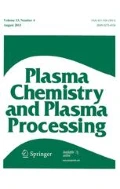Abstract
With the Gibbs free energy method, we determine the molar fraction in a plasma at and out of thermal equilibrium consisting of air and aluminum for several percentages in the temperature range of 500–6000 K. We take three temperatures into account (T rot = T h ; T vib ; T ex = T e ). We indicate the formulae and the numerical method used to perform the calculation taking three condensed phases AlN, Al, Al2O3 into account. We show that the air percentage plays a major role to create these phases. We clarify the role plays on the vaporization temperatures and on the sublimation temperature by the non-thermal equilibrium of the plasma. This kind of plasma is found in arc roots, near a wall, in plasmas with a high value of electrical field,… The influence of the pressures until 30 × 105 Pa. is shown on molar fraction of the chemical species, on the vaporization temperatures and on the sublimation temperature. The vaporization temperatures are given versus the thermal non equilibrium versus various mixtures (air, aluminum) and versus the pressures (105 Pa–30 × 105 Pa).





Similar content being viewed by others
References
André P (1995) Partition functions and concentrations in plasmas out of thermal equilibrium. IEEE Trans Plasma Sci 23(3):453
André P, Koalaga Z (2010) Composition of a thermal plasma formed from PTFE with copper in non-oxidant atmosphere Part I Definition of a test case with the SF6. High Temp Mater Process Int Q High-Technol Plasma Process 14(3):285–294
André P, Lefort A (1998) The influence of thermal disequilibrium on a plasma consisting of insulator vapours. J Phys D Appl Phys 31(6):717
André P, Barinov Y, Faure G, Shkol’nik S (2011) Modelling radiation spectrum of a discharge with two liquid non-metallic (tap-water) electrodes in air at atmospheric pressure. J Phys D Appl Phys 44(37):375203
André P, Bussière W, Coulbois A, Gelet J, Rochette D (2016) Modelling of electrical conductivity of a silver plasma at low temperature. Plasma Sci Technol (accepted)
Aubreton J, Elchinger M, André P (2013) Influence of Partition Function and Intercation Potential on Transport Properties of Thermal Plasmas. Plasma Chem Plasma Process 33(1):367–399
Augeard A, Desprez P, Singo T, Abbaoui M (2015) Observation par caméra rapide des spots cathodiques dans l’air au niveau du CID des éléments batterie lithium-ion. JITIPEE 1:1–9
Capitelli M, Molinari E (1970) Problems of determination of high temperature thermodynamic properties of rare gases with application to mixtures. J Plasma Phys 4(2):335–355
Chase MW (1998) NIST-JANAF thermochemical tables (Journal of physical and chemical reference data monograph No. 9), 4th edn. American Chemical Society and the American Institute of Physics for NIST (National Institute of Standards and Technology)
Drellishak K, Aeschliman D, Cambel Ali Bulent (1965) Partition functions and thermodynamic properties of nitrogen and oxygen plasmas. Phys Fluids 8(9):1590
Dricot F, Reher H (1994) Survey of arc tracking on aerospace cables and wires. IEEE Trans Dielectr Electr Insul 1(5):896–903
Fridman A, Kennedy L (2004) Plasma physics and engineering. Taylor & Francis, New York
Giordano D, Capitelli M (2002) Nonuniqueness of the two temperature Saha equation and related consideration. Phys Rev E 65:016401
Giordano D, Capitelli M (1995) Two-temperature Saha Equation a misunderstood problem. J Thermophys Heat Transfer 9(4):803
Gordon S, McBride B (1976) Computer Program for calculation of complex chemical equilibrium compositions, Rocket Performance Incident and reflected shocks and chapman jouguet detonation. NASA
Haynes W, Lide D, Bruno T (2012) CRC Handbook of chemistry and physics, 93rd edn. CRC Press, Taylor & Francis Group
Lefort A, Abbaoui M (2012) Theory about arc root: a review. IOP Cof Ser Mater Sci Eng 29:012006
Lesaint P, Touzani R (1989) Approximation of the heat equation in a variable doamin with application to the Stefan problem. SIAM J Numer Anal 26(2):366–379
Murphy AB (2015) Why the arc and its interactions with the electrodes are important in predictive modelling of arc welding. Plasma Phys Technol 2(3):233–240
Murphy A, Tanaka M, Yamamoto K, Sato T, Lowke J (2009) Modelling of thermal plasmas for arc welding: the role of the shielding gas properties and of metal vapour. J Phys D Appl Phys 42:194006
NIST. (s.d.). Récupéré sur NIST Atomic Spectra Database Levels Data: http://physics.nist.gov/PhysRefData/ASD/levels_form.html
Raja LL, Varghese P, Wilson D (1997) Modeling of the electrothermal ignitor metal vapor plasma for electrothermal-chemical guns. IEEE Trans Magn 33(1):316–321
Rochette D, Bussière W, André P (2004) Composition, enthalpy, and vaporization temperature calculation of Ag–SiO2 plasmas with air in the temperature range from 1000 to 6000 K and for pressure included between 1 and 50 bars. Plasma Chem Plasma Process 24(3):475–492
Rong M, Wang W, Yan J, Murphy A, Spencer J (2011) Thermophysical properties of nitrogen plasmas under thermal equilibrium and non-equilibrium conditions. Phys Plasmas 18:113502. doi:10.1063/1.3657426
Rossignol J, Abbaoui M, Clain S (2000) Numerical modelling of thermal ablation phenomena due to a cathodic spot. J Phys D Appl Phys 33:2079–2086
Staack D, Bakhtier F, Gutsol A, Fridman A (2005) Characterization of a dc atmospheric pressure normal glow discharge. Plasma Sour Sci Technol 14(4):700–711
Zhao TL, Xu Y, Song YH, Li XS, Liu JL, Liu JB, Zhu AM (2013) Determination of vibrational and rotational temperatures in a gliding arc discharge by using overlapped molecular emission spectra. J Phys D Appl Phys 46(34):345201
Wade K, Banister A (1975) The chemistry of aluminium, gallium, indium and thallium. Pergamon Press, Oxford
Author information
Authors and Affiliations
Corresponding author
Rights and permissions
About this article
Cite this article
André, P., Abbaoui, M., Augeard, A. et al. Study of Condensed Phases, of Vaporization Temperatures of Aluminum Oxide and Aluminum, of Sublimation Temperature of Aluminum Nitride and Composition in an Air Aluminum Plasma. Plasma Chem Plasma Process 36, 1161–1175 (2016). https://doi.org/10.1007/s11090-016-9704-7
Received:
Accepted:
Published:
Issue Date:
DOI: https://doi.org/10.1007/s11090-016-9704-7
Keywords
- Aluminum nitride
- Aluminum oxide
- Aluminum
- Plasma
- Vaporization temperature
- Sublimation temperature
- Chemical equilibrium
- Multitemperature plasma


